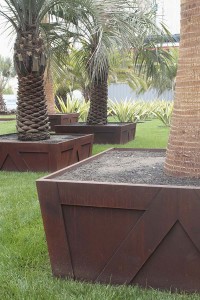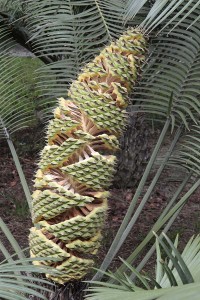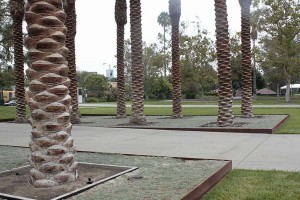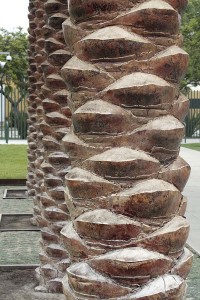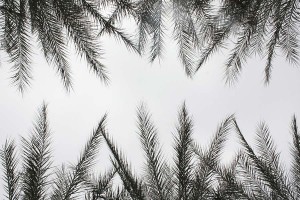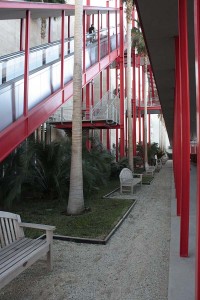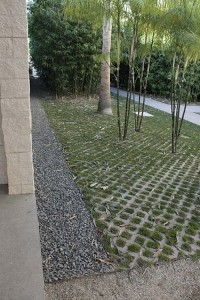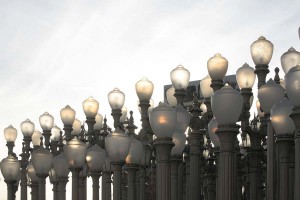I’m sure I’m not the first to have noticed the irony: The main approach to Los Angeles County Museum of Art takes you through the BP Grand Entrance. The back way in takes you through the La Brea Tar Pits.
When I took the photos on the last day of July crude oil was still gushing into the Gulf of Mexico, and the irony was heavy like the odor of tar coming from the fenced-off pits where archaeologists were working behind the museum on extracting critters and plants that got caught in the ancestral goo.
Here, junior’s ball has somehow made it over the fence around one of the pits. You could maybe rescue it with a stick…or you could wade through the tar and hope that you don’t get caught, only to be discovered by archaeologists a few millennia down the road.
We arrived at the museum an hour before it opened, via the back entrance, so we had a chance to spend some time with Robert Irwin’s Palm Garden Installation. I posted [ before ] on the earlier stages of the garden, and it’s still not complete. But by now you can really make out many more of the elements of what the final garden will look like.
There are many palm species used in the garden. A number of them are planted in a lawn, inside planter boxes that mimic the wooden planter boxes the trees were grown in. But unlike the wooden temporary planters, these permanent homes are made out of thick steel plate–the “it” material of the moment for well-financed modern gardens.
A closer look at the planter box…
In a back corner you could see a collection of palms in pots, and in this photo you can get a better idea of the kind of planter box the steel ones are meant to suggest.
Another look at some of the palms in transition… In this installation some of the plants are rotated out according tot he season. I’m not sure whether these are headed in or out.
LACMA was about to open a new facility, the Resnick Pavillion designed by Renzo Piano. As the building nears completion more elements of the Palm Garden Installation are being planted. In addition to palms it includes several of the non-palm species. These are some spectacularly variegated agaves plants of a furcraea, possibly Furcraea foetida ‘Mediopicta’–Thanks for the correction, Loree!
The way the plants have been shaped, with the lowest leaves removed, made them look like variegated New Zealand flax (phormiums) until you got close to them. It’s not a bad look. It’ll be interesting to see if these agaves furcraeas are kept pruned this way or whether they’ll be allowed to grow into the rosettes that agave furcraea growers are used to seeing. This is in no way a naturalistic garden, so my guess is that the agaves plants will be kept this shape. Besides, how do you mow around them without running over the leaves?


Another of the non-palm species: this cycad developing this really cool cone. It’s probably something like three to four feet long.
A bench and real palms outside the Resnick pavilion…
The single most dramatic gesture is the placement of this palm with a thickly bulbous trunk that’s been planted in a tight opening that leads two stories down into a parking garage. The effect is like staring down into a North Dakota Minuteman missile silo. It’s more than a tad unsettling, and asserts that garden-making can be about more than designing pleasant, unchallenging spaces.
Say “Los Angeles” to someone and ask them what comes to mind. Palm trees would probably be one of the first things the person might bring up, even though the city’s official tree is the coral tree is and the official flower the bird of paradise. “Cars” would probably be another. Here palms and cars come together, with a short arcade of the trees lining the driveway down into the parking garage.
I’m not anything remotely resembling a palm expert, so I can’t tell you what species this is. But I can show you that it has amazingly sculptural trunks.
Looking up into the fronds gives you the sensation closest what you get from many of the artworks Robert Irwin did before he designed gardens. The fronds filter the light in interesting ways, and two or more layers make things darker than just a single layer. If you stand in the driveway and look straight up the negative space of the sky reads like a bright zigzag between the delicate layers of palm.

If you’d like to compare the effect of the palm fronds to an earlier Irwin piece, here’s a corner of his Running Violet V Forms, a piece that I walk around and under at least twice a week. In this 1980s piece panels of violet-colored mesh turn light or dark, depending on the number of layers, and the mesh turns opaque or transparent depending on how the light is striking it. The mesh interacts with views of the eucalyptus grove where it’s placed. I’ve loved this piece ever since the day it went up. You can read my love story with this piece [ here ].
Artists often complain that big museums don’t pay enough attention to local artists in their scramble to show off big-name artists from the other coast or another country. This summer day LACMA had several galleries devoted to the the photographs of Cathy Opie, and work of other local artists could be found the walls of several of the galleries. But I didn’t identify any plant species used in this garden that came from within a thousand-mile radius.
Word is that Robert Irwin is designing yet another garden, this one for a new federal courthouse here in San Diego. Wouldn’t it be great if he could use some of our California species in the project? What about some of our delicately transparent plants like deer weed or broom baccharis? Or what about some of the many plants that undergo stunning transformations as the seasons change? To see an important new, high profile garden comprised of local natives would be such an amazing opportunity.





